Impact of Pilot Injection on Combustion and Emission Characteristics of a Low-Speed Two-Stroke Marine Diesel Engine
Abstract
:1. Introduction
2. Numerical Methodologies
2.1. Test Engine
2.2. Model Description
2.3. Experimental Validation
3. Results and Discussion
3.1. In-Cylinder Pressure and Heat Release Rate (HRR)
3.2. In-Cylinder Distribution of Initial Phase of Combustion
3.3. In-Cylinder Distribution of Middle Phase of Combustion
3.4. In-Cylinder Distribution of Final Phase of Combustion
3.5. Boundary Heat Transferring
3.6. Overall Performance
4. Conclusions
Author Contributions
Funding
Institutional Review Board Statement
Informed Consent Statement
Data Availability Statement
Acknowledgments
Conflicts of Interest
Abbreviations
| °CA ATDC | Degree crank angle after top dead center |
| °CA BTDC | Degree crank angle before top dead center |
| °CA | Degree crank angle |
| CONVERGE | 3-dimesional CFD software |
| KH-RT | Kelvin-Helmholtz and Rayleigh-Taylor Breakup Model |
| RNG K-ε | Renormalization Group K-ε turbulence model |
| SAGE | Detailed chemical kinetics model in CONVERGE |
| CTC | Characteristic time combustion model |
| Hiroyasu-NSC | Hiroyasu model coupled with Nagle and Strickland-Constable model |
References
- Jia, X.; Sun, B.; Wu, D.-W.; Xu, D.; Zang, W.; Shang, W.; Wang, J. Analysis on the Influence of Key Parameters of Control Valve on the Performance Characteristics of Electromagnetic Injector. SAE Tech. Pap. Ser. 2017, 1. [Google Scholar] [CrossRef]
- Sun, Z.-Y.; Li, G.-X.; Chen, C.; Yu, Y.-S.; Gao, G.-X. Numerical investigation on effects of nozzle’s geometric parameters on the flow and the cavitation characteristics within injector’s nozzle for a high-pressure common-rail DI diesel engine. Energy Convers. Manag. 2015, 89, 843–861. [Google Scholar] [CrossRef]
- Li, R.; Meng, X.; Xie, Y. A tribological analysis on stuffing box-piston rod system of low-speed marine diesel engines. Int. J. Engine Res. 2019, 20, 911–930. [Google Scholar] [CrossRef]
- Babu, D.; Karvembu, R.; Ramanathan, A. Impact of split injection strategy on combustion, performance and emissions characteristics of biodiesel fuelled common rail direct injection assisted diesel engine. Energy 2018, 165, 577–592. [Google Scholar] [CrossRef]
- Fan, L.; Wen, L.; Bai, Y.; Lan, Q.; Lu, Z. Influential factors on pressure characteristics of fuel system for a low-speed marine diesel engine. Int. J. Engine Res. 2020, 12, 1468087420917284. [Google Scholar] [CrossRef]
- Yoon, S.H.; Cha, J.P.; Lee, C.S. An investigation of the effects of spray angle and injection strategy on dimethyl ether (DME) combustion and exhaust emission characteristics in a common-rail diesel engine. Fuel Process. Technol. 2010, 91, 1364–1372. [Google Scholar] [CrossRef]
- Andreadis, P.; Zobanakis, A.; Chryssakis, C.; Kaiktsis, L. Effects of fuel injection parameters on performance and emissions formation in a large-bore marine diesel engine. Int. J. Engine Res. 2010, 1, 1–14. [Google Scholar] [CrossRef]
- Wang, D.; Shi, L.; Zhu, S.; Liu, B.; Qian, Y.; Deng, K. Numerical and thermodynamic study on effects of high and low pressure exhaust gas recirculation on turbocharged marine low-speed engine. Appl. Energy 2020, 261, 114346. [Google Scholar] [CrossRef]
- Mera, Z.; Fonseca, N.; López, J.-M.; Casanova, J. Analysis of the high instantaneous NOx emissions from Euro 6 diesel passenger cars under real driving conditions. Appl. Energy 2019, 242, 1074–1089. [Google Scholar] [CrossRef]
- Park, S.; Cho, J.; Park, J. Numerical methodology on virtual model extension and system-level optimization of light-duty diesel vehicle with dual-loop exhaust gas recirculation. Appl. Energy 2019, 242, 1422–1435. [Google Scholar] [CrossRef]
- Beatrice, C.; Denbratt, I.; Di Blasio, G.; Di Luca, G.; Ianniello, R.; Saccullo, M. Experimental Assessment on Exploiting Low Carbon Ethanol Fuel in a Light-Duty Dual-Fuel Compression Ignition Engine. Appl. Sci. 2020, 10, 7182. [Google Scholar] [CrossRef]
- Fang, J.; Meng, Z.; Li, J.; Du, Y.; Qin, Y.; Jiang, Y.; Bai, W.; Chase, G.G. The effect of operating parameters on regeneration characteristics and particulate emission characteristics of diesel particulate filters. Appl. Therm. Eng. 2019, 148, 860–867. [Google Scholar] [CrossRef]
- Stamatellou, A.-M.; Stamatelos, A. Overview of Diesel particulate filter systems sizing approaches. Appl. Therm. Eng. 2017, 121, 537–546. [Google Scholar] [CrossRef]
- Konstandopoulos, A.G.; Kostoglou, M.; Beatrice, C.; Di Blasio, G.; Imren, A.; Denbratt, I. Impact of combination of EGR, SCR, and DPF technologies for the low-emission rail diesel engines. Emiss. Control Sci. Technol. 2015, 1, 213–225. [Google Scholar] [CrossRef] [Green Version]
- Gao, J.; Tian, G.; Sorniotti, A.; Karci, A.E.; Di Palo, R. Review of thermal management of catalytic converters to decrease engine emissions during cold start and warm up. Appl. Therm. Eng. 2019, 147, 177–187. [Google Scholar] [CrossRef]
- Bai, S.; Han, J.; Liu, M.; Qin, S.; Wang, G.; Li, G.-X. Experimental investigation of exhaust thermal management on NOx emissions of heavy-duty diesel engine under the world Harmonized transient cycle (WHTC). Appl. Therm. Eng. 2018, 142, 421–432. [Google Scholar] [CrossRef]
- Poorghasemi, K.; Ommi, F.; Yaghmaei, H.; Namaki, A. An investigation on effect of high pressure post injection on soot and NO emissions in a DI diesel engine. J. Mech. Sci. Technol. 2012, 26, 269–281. [Google Scholar] [CrossRef]
- Korkmaz, M.; Zweigel, R.; Jochim, B.; Beeckmann, J.; Abel, D.; Pitsch, H. Triple-injection strategy for model-based control of premixed charge compression ignition diesel engine combustion. Int. J. Engine Res. 2018, 19, 230–240. [Google Scholar] [CrossRef]
- O’Connor, J.; Musculus, M. Post injections for soot reduction in diesel engines: A review of current under-standing. SAE Int. J. Engines 2013, 6, 400–421. [Google Scholar] [CrossRef] [Green Version]
- Cung, K.; Moiz, A.; Johnson, J.; Le, S.-Y.; Kweon, C.-B.; Montanaro, A. Spray–combustion interaction mechanism of multiple-injection under diesel engine conditions. Proc. Combust. Inst. 2015, 35, 3061–3068. [Google Scholar] [CrossRef] [Green Version]
- Beatrice, C.; Di Blasio, G.; Belgiorno, G. Experimental analysis of functional requirements to exceed the 100 kW/l in high-speed light-duty diesel engines. Fuel 2017, 207, 591–601. [Google Scholar] [CrossRef]
- Babu, J.M.; Prasad, K.S.; Ganji, P.R.; Ravikiran, C.; Velu, R. Analysis on the effect of pilot injection strategies on combustion and emission characteristics of palm-munja biodiesel/diesel blend on CRDI diesel engine. Int. J. Ambient. Energy 2019, 1–4. [Google Scholar] [CrossRef]
- Lee, J.; Hong, K.; Choi, S.; Yu, S.; Choi, H.; Min, K. Comparison of the effects of multiple injection strategy on the emissions between moderate and heavy EGR rate conditions: Part 1-pilot injections. J. Mech. Sci. Technol. 2013, 27, 1135–1141. [Google Scholar] [CrossRef]
- Yadav, J.; Ramesh, A. Comparison of Single and Multiple Injection Strategies in a Butanol Diesel Dual Fuel Engine. J. Energy Resour. Technol. 2018, 140, 072206. [Google Scholar] [CrossRef]
- Park, C.; Busch, S. The influence of pilot injection on high-temperature ignition processes and early flame structure in a high-speed direct injection diesel engine. Int. J. Engine Res. 2017, 19, 668–681. [Google Scholar] [CrossRef]
- Yin, L.; Lundgren, M.; Wang, Z.; Stamatoglou, P.; Richter, M.; Andersson, Ö.; Tunestål, P. High efficient internal combustion engine using partially premixed combustion with multiple injections. Appl. Energy 2019, 234, 516–523. [Google Scholar] [CrossRef]
- Gao, T.; Yu, S.; Li, T.; Zheng, M. Impacts of multiple pilot diesel injections on the premixed combustion of ethanol fuel. Proc. Inst. Mech. Eng. Part D J. Automob. Eng. 2017, 232, 738–754. [Google Scholar] [CrossRef]
- Niki, Y.; Nitta, Y.; Sekiguchi, H.; Hirata, K. Diesel Fuel Multiple Injection Effects on Emission Characteristics of Diesel Engine Mixed Ammonia Gas Into Intake Air. J. Eng. Gas Turbines Power 2019, 141, 061020. [Google Scholar] [CrossRef]
- Huang, H.; Zhu, Z.; Chen, Y.; Chen, Y.; Lv, D.; Zhu, J.; Ouyang, T. Experimental and numerical study of multiple injection effects on combustion and emission characteristics of natural gas–diesel dual-fuel engine. Energy Convers. Manag. 2019, 183, 84–96. [Google Scholar] [CrossRef]
- How, H.; Masjuki, H.H.; Kalam, M.; Teoh, Y. Influence of injection timing and split injection strategies on performance, emissions, and combustion characteristics of diesel engine fueled with biodiesel blended fuels. Fuel 2018, 213, 106–114. [Google Scholar] [CrossRef]
- Busch, S.; Zha, K.; Miles, P.C. Investigations of closely coupled pilot and main injections as a means to reduce combustion noise in a small-bore direct injection diesel engine. Int. J. Engine Res. 2015, 16, 13–22. [Google Scholar] [CrossRef]
- Lee, C.; Lee, C.; Lee, K. Emission Characteristics for a Homogeneous Charged Compression Ignition Diesel Engine with Exhaust Gas Recirculation Using Split Injection Methodology. Energies 2017, 10, 2146. [Google Scholar] [CrossRef] [Green Version]
- Liu, J.; Wang, H.; Zheng, Z.; Li, L.; Mao, B.; Xia, M.; Yao, M. Improvement of high load performance in gasoline compression ignition engine with PODE and multiple-injection strategy. Fuel 2018, 234, 1459–1468. [Google Scholar] [CrossRef]
- Le, T.D.; Masjuki, H.H.; How, H.G.; Kalam, M.; Yu, K.H.; Alabdulkarem, A. Effect of two-stage injection dwell angle on engine combustion and performance characteristics of a common-rail diesel engine fueled with coconut oil methyl esters-diesel fuel blends. Fuel 2018, 234, 227–237. [Google Scholar] [CrossRef]
- Herfatmanesh, M.R.; Lu, P.; Attar, M.A.; Zhao, H. Experimental investigation into the effects of two-stage injec-tion on fuel injection quantity, combustion and emissions in a high-speed optical common rail diesel engine. Fuel 2013, 109, 137–147. [Google Scholar] [CrossRef] [Green Version]
- Maes, N.; Bakker, P.; Dam, N.; Somers, B. Transient Flame Development in a Constant-Volume Vessel Using a Split-Scheme Injection Strategy. SAE Int. J. Fuels Lubr. 2017, 10, 318–327. [Google Scholar] [CrossRef] [Green Version]
- Pandey, S.K.; Vandana, S.; Akella, S.S.; Ravikrishna, R. Potential of Early Direct Injection (EDI) for simultaneous NOx and soot emission reduction in a heavy duty turbocharged diesel engine. Appl. Therm. Eng. 2019, 158, 113762. [Google Scholar] [CrossRef]
- Taghavifar, H. Application of Divergent Split Injection in A Cidi Diesel Engine To Reduce Emissions And Boost The Efficiency. Transp. 2019, 34, 115–125. [Google Scholar] [CrossRef] [Green Version]
- Dawson, M.; Borman, D.; Hammond, R.B.; Lesnic, D.; Rhodes, D. Moving boundary models for the growth of crystalline de-posits from undetected leakages of industrial process liquors. Comput. Chem. Eng. 2014, 71, 331–346. [Google Scholar] [CrossRef] [Green Version]
- Gafoor, C.A.; Gupta, R. Numerical investigation of piston bowl geometry and swirl ratio on emission from diesel engines. Energy Convers. Manag. 2015, 101, 541–551. [Google Scholar] [CrossRef]
- Abraham, J.; Bracco, F.; Reitz, R. Comparisons of computed and measured premixed charge engine combustion. Combust. Flame 1985, 60, 309–322. [Google Scholar] [CrossRef]
- Xin, J.; Ricart, L.; Reitz, R. Computer Modeling of Diesel Spray Atomization and Combustion. Combust. Sci. Technol. 1998, 137, 171–194. [Google Scholar] [CrossRef]
- Halstead, M.; Kirsch, L.; Quinn, C. The autoignition of hydrocarbon fuels at high temperatures and pressures—Fitting of a mathematical model. Combust. Flame 1977, 30, 45–60. [Google Scholar] [CrossRef]
- Komninos, N.; Rakopoulos, C.D. Heat transfer in hcci phenomenological simulation models: A review. Appl. Energy 2016, 181, 179–209. [Google Scholar] [CrossRef]
- Richards, K.J.; Senecal, P.K.; Pomraning, E. Converge v2. 3 Manual; Convergent Science, Inc.: Madison, WI, USA, 2016. [Google Scholar]
- Zhang, E.; Liang, X.; Zhang, F.; Yang, P.; Cao, X.; Wang, X.; Yu, H. Evaluation of Exhaust Gas Recirculation and Fuel Injection Strategies for Emission Performance in Marine Two-Stroke Engine. Energy Procedia 2019, 158, 4523–4528. [Google Scholar] [CrossRef]
- Liang, X.Y.; Yang, P.J.; Zhang, F.; Zhang, E.X.; Cao, X.Y.; Liu, T. Research on EGR Mechanism of NOx Reduction on a Large-bore Marine Diesel Engine by 3D-CFD Simulation. In Proceedings of the 29th CIMAC World Congress, Vancouver, BC, Canada, 10–14 June 2019; p. 195. [Google Scholar]
- Yoon, S.H.; Kim, H.J.; Park, S. Study on optimal combustion strategy to improve combustion performance in a single-cylinder PCCI diesel engine with different combustion chamber geometry. Appl. Therm. Eng. 2018, 144, 1081–1090. [Google Scholar] [CrossRef]
- Hwang, J.; Park, Y.; Kim, K.; Lee, J.; Bae, C. Improvement of diesel combustion with multiple injections at cold condition in a constant volume combustion chamber. Fuel 2017, 197, 528–540. [Google Scholar] [CrossRef]
- Indudhar, M.R.; Banapurmath, N.R.; Rajulu, K.G.; Khan, T.M.Y.; Manoj, E.K. Effects of single and split injection on the performance, emission and combustion attributes of a CRDI engine powered with diesel and honge biodiesel. Sustain. Energy Fuels 2019, 3, 2275–2286. [Google Scholar] [CrossRef]

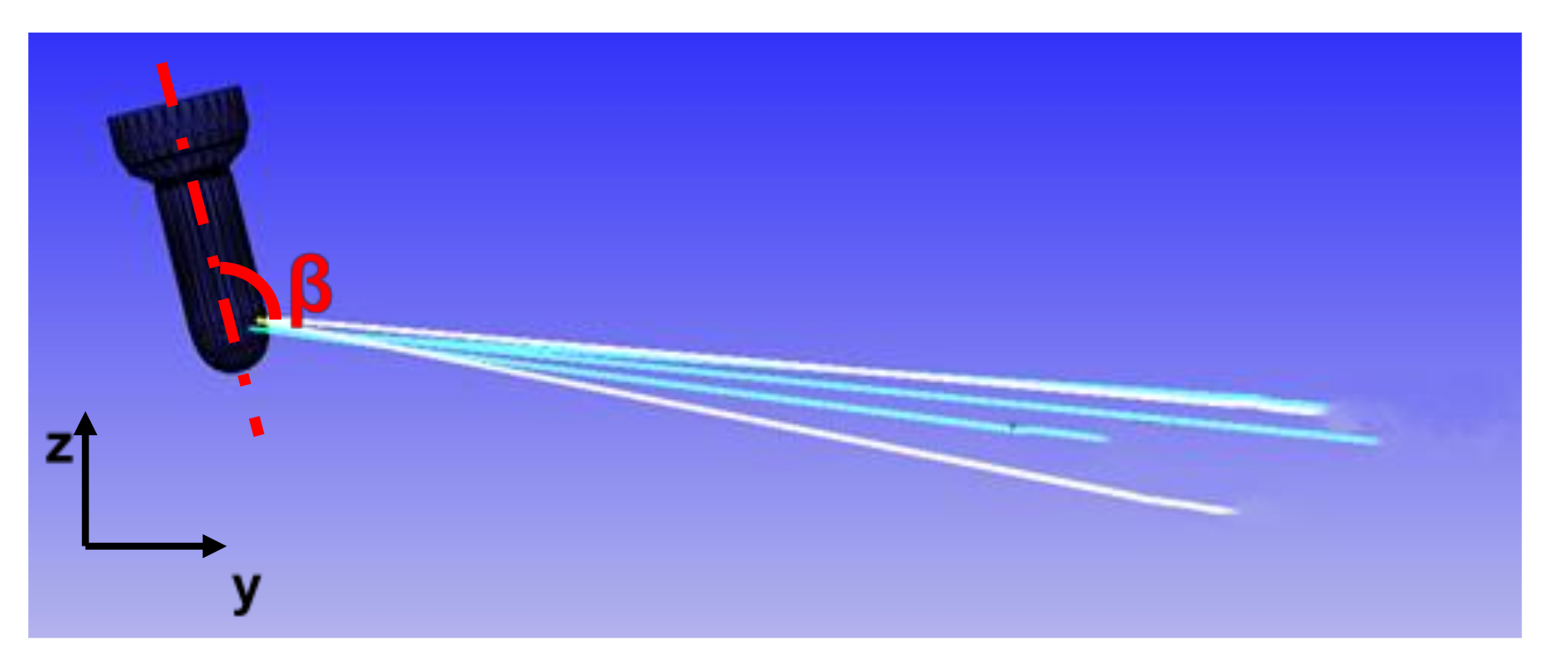

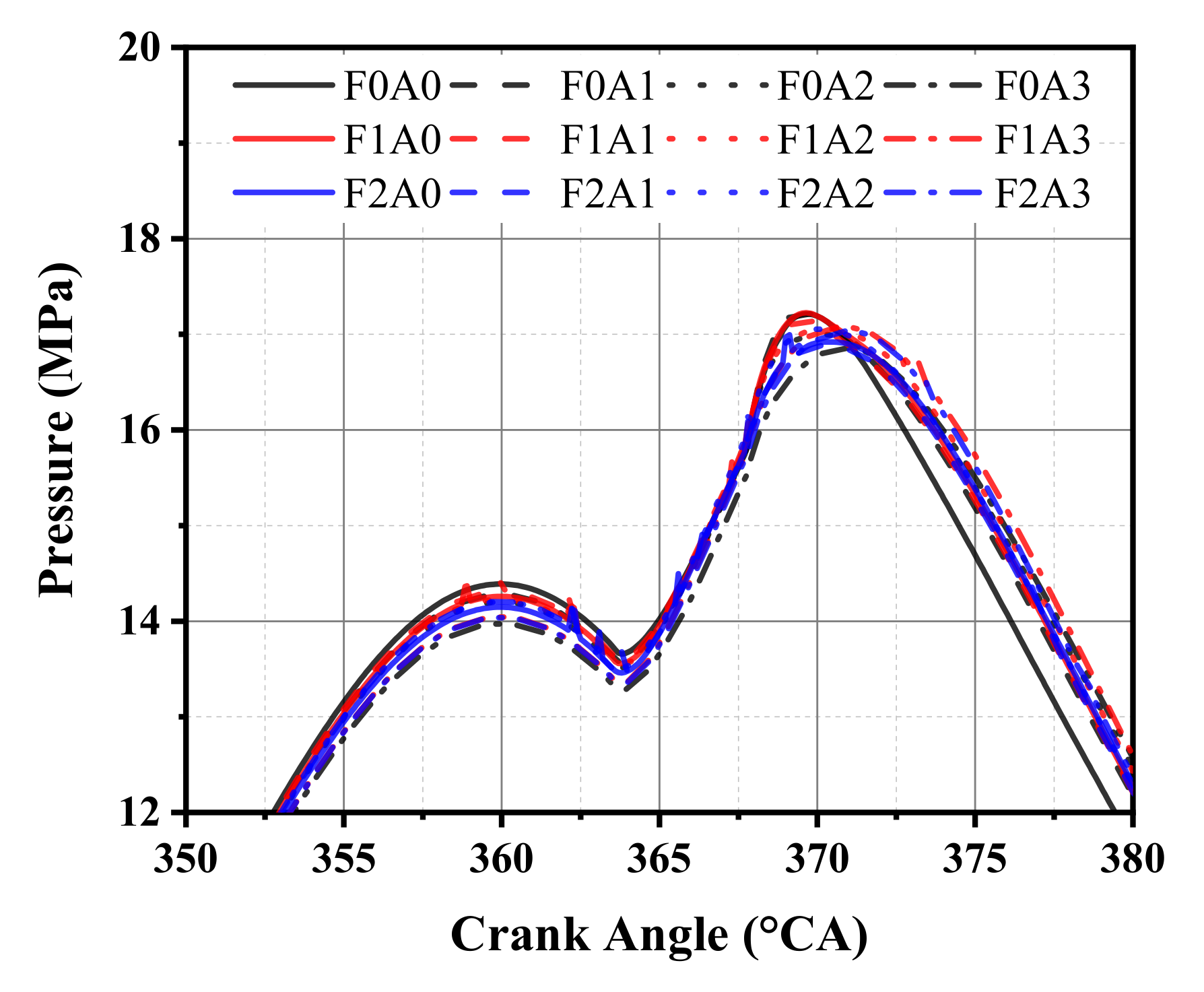


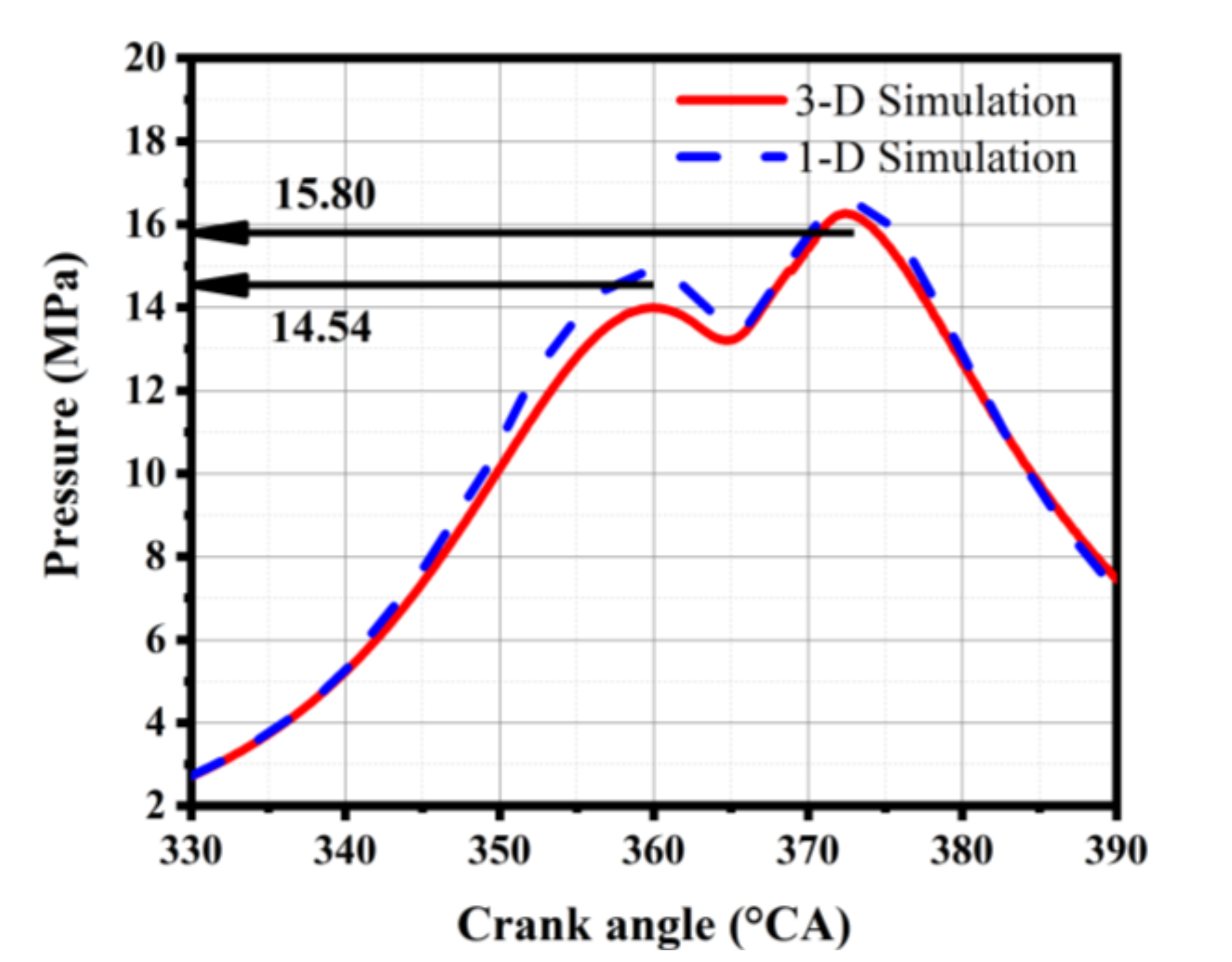

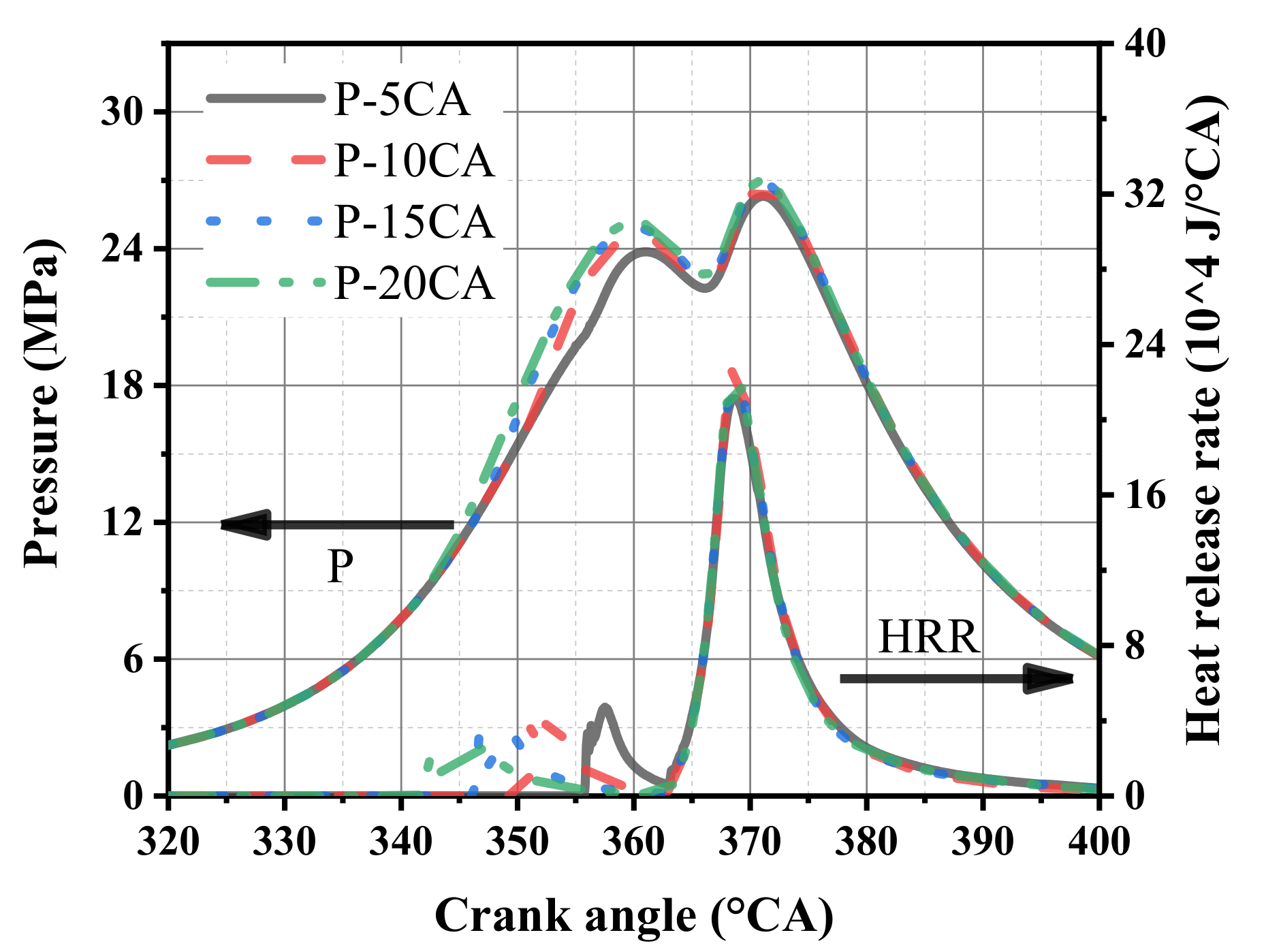


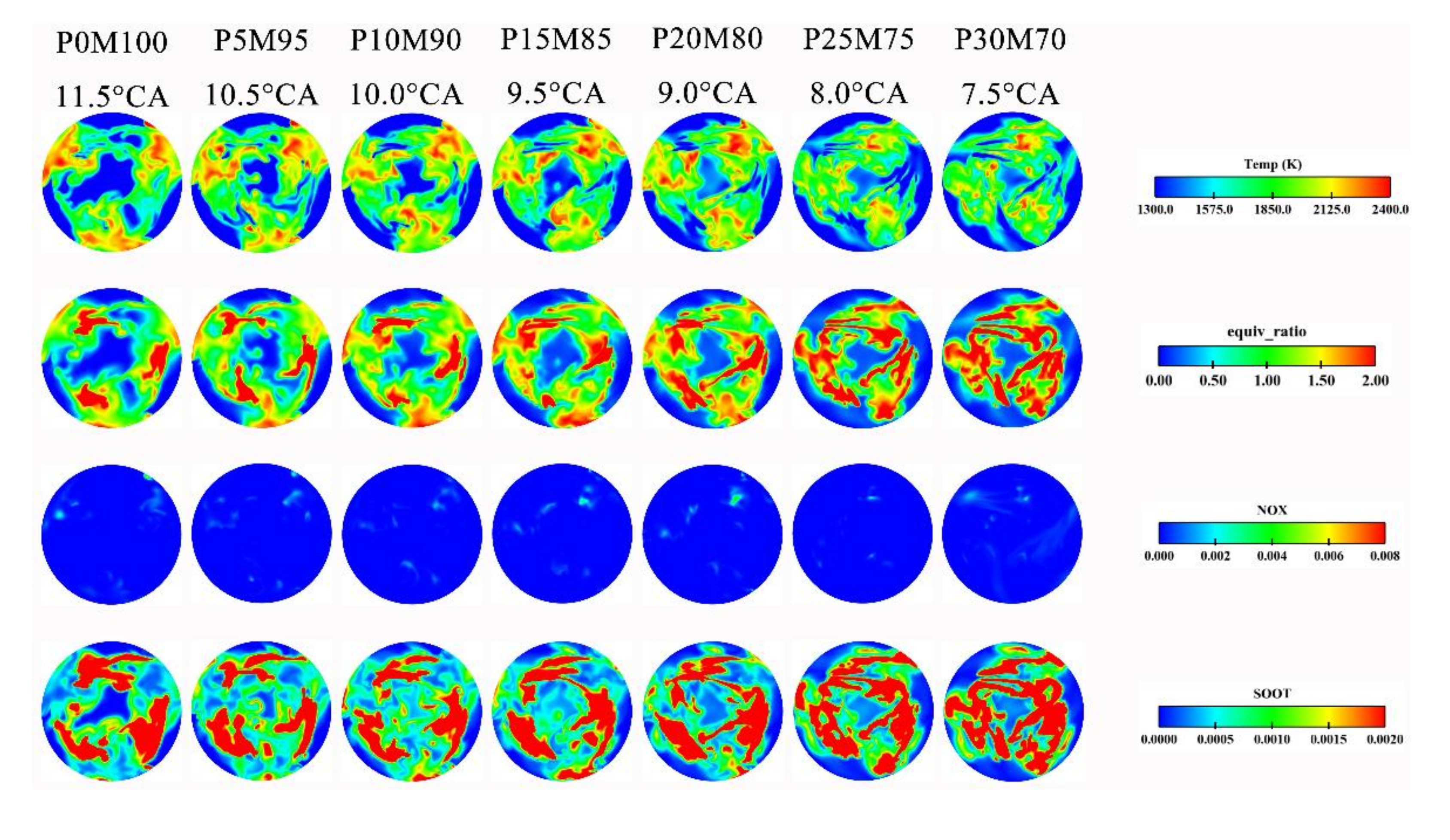

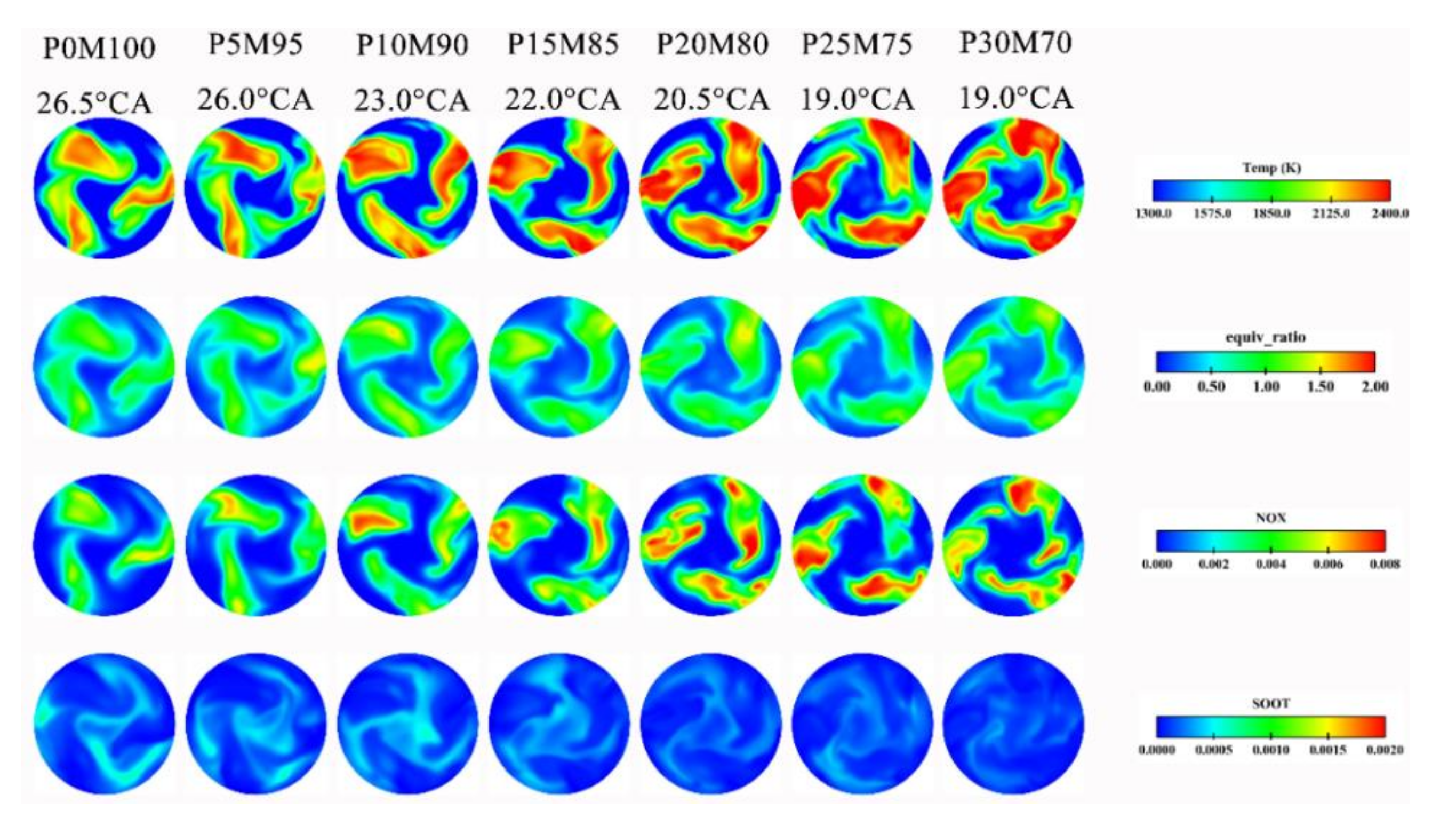
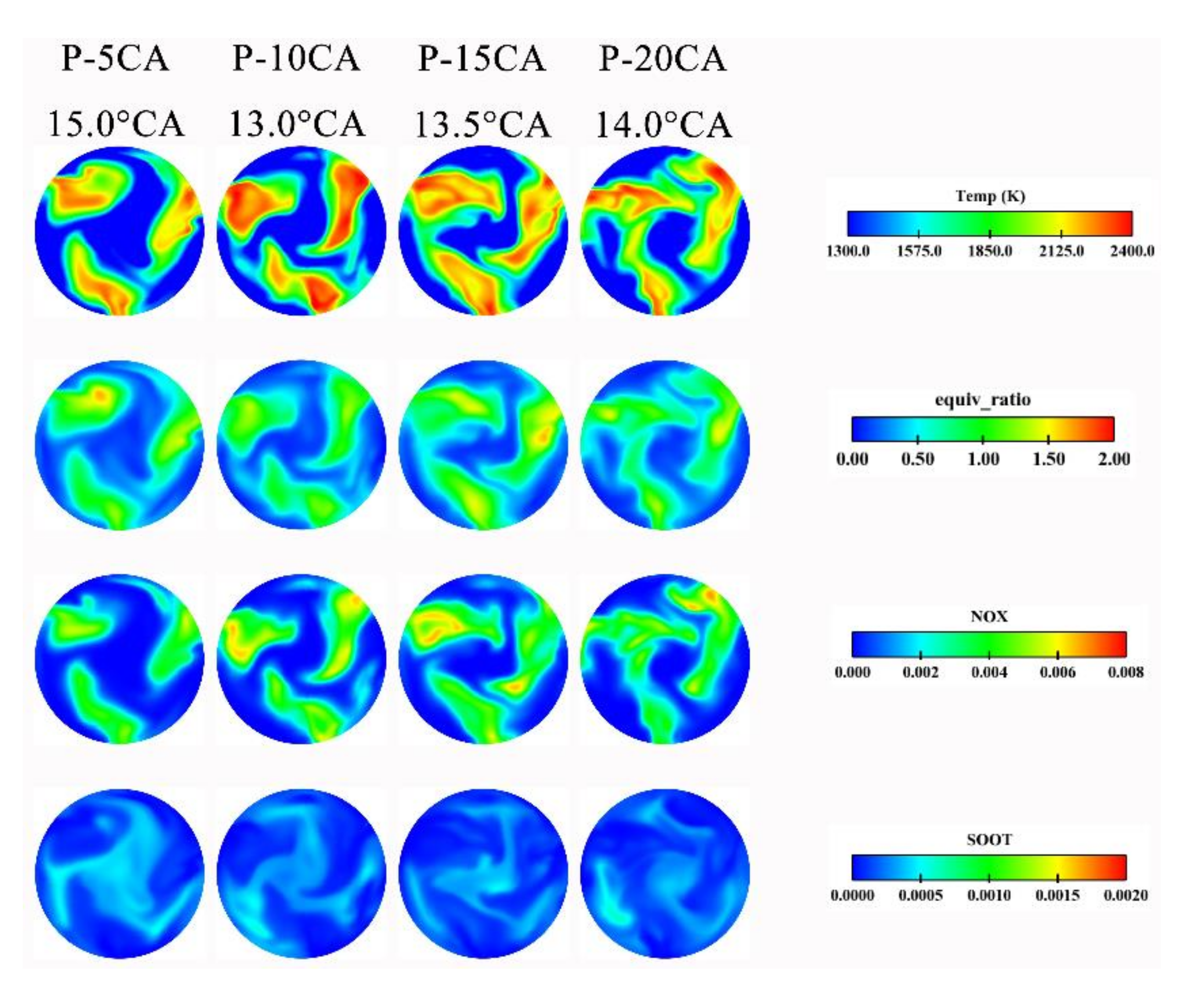
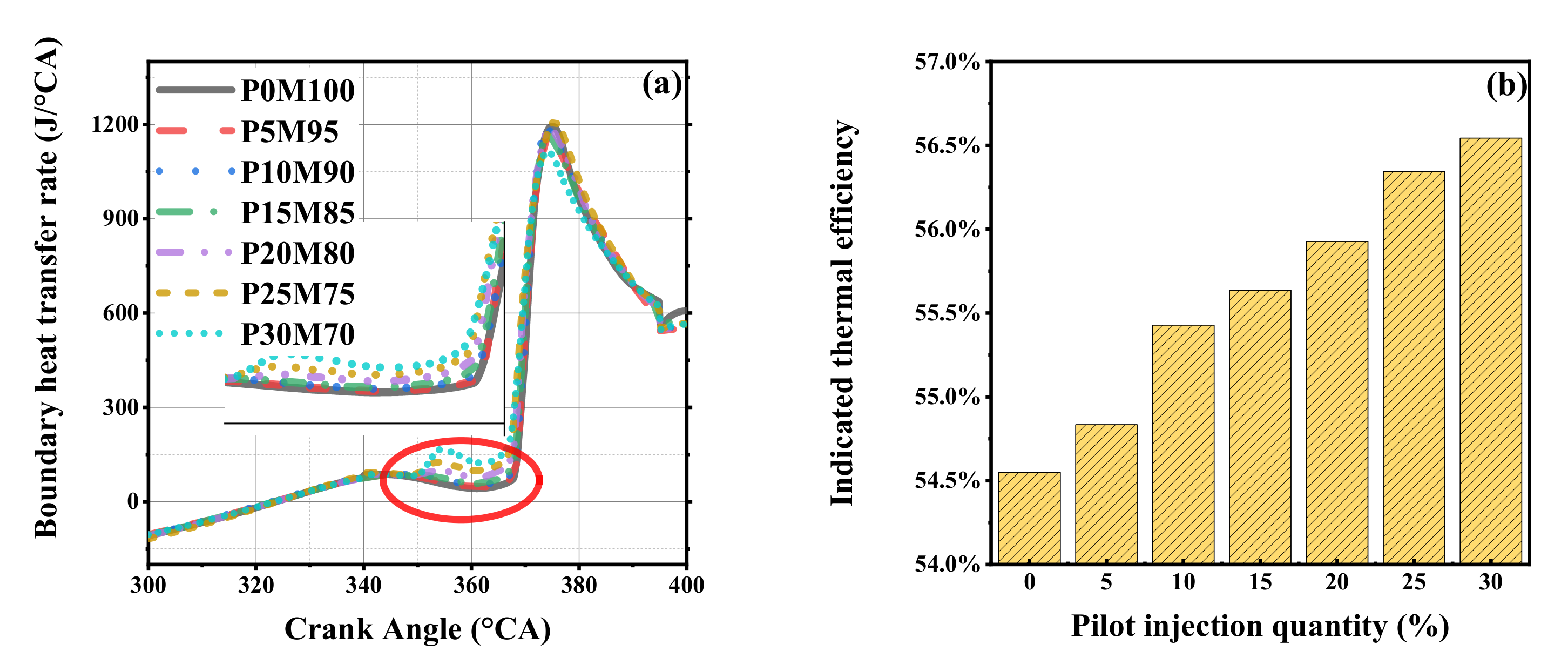

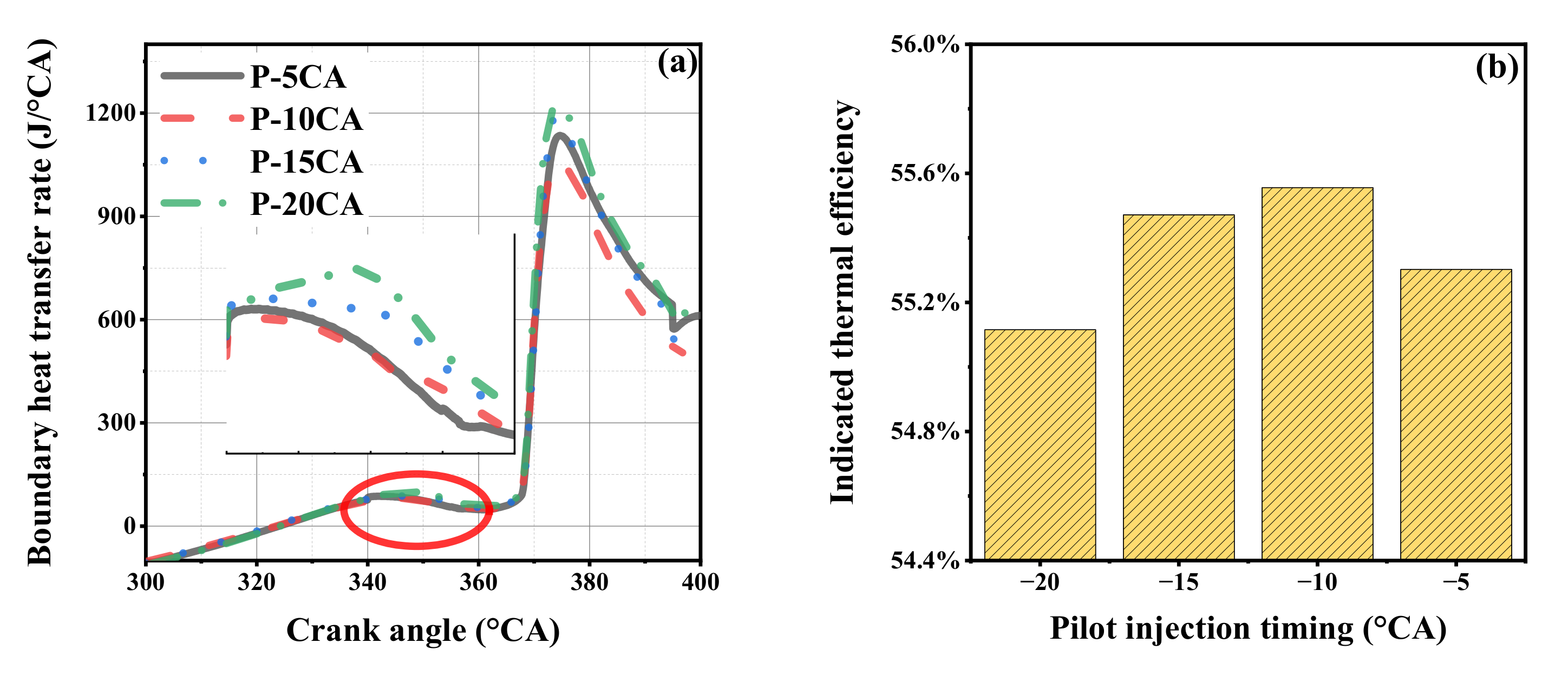
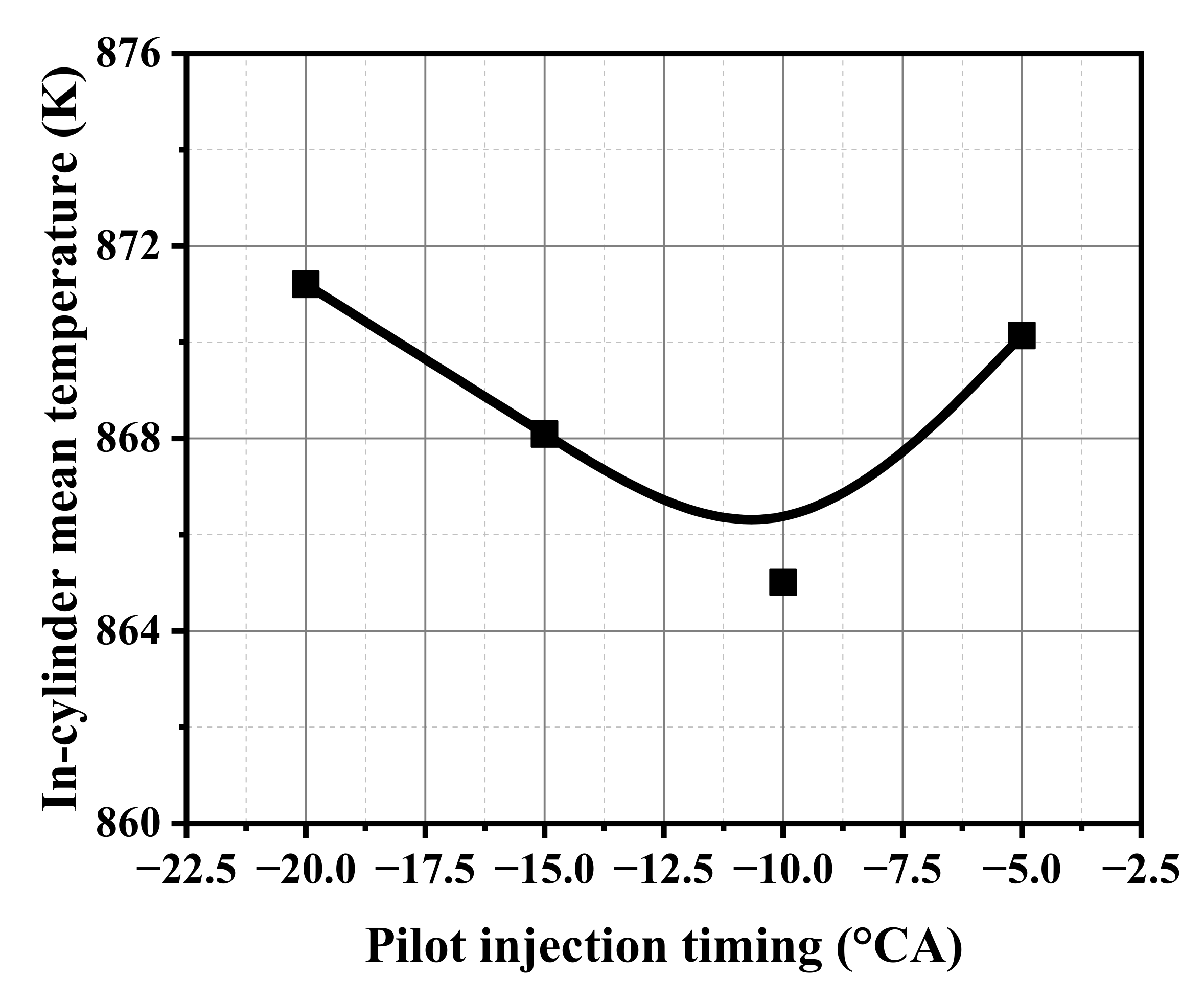

| Parameter | Bore (m) | Speed (r/min) | Stroke (m) | Compression Ratio | Output (kW) | Mean Effective Pressure (bar) |
|---|---|---|---|---|---|---|
| Value | 0.52 | 99 | 2.315 | 24.91 | 6408 | 15.8 |
| Operating Parameters on Different Loads (%) | 25 | 50 | 75 | 100 |
|---|---|---|---|---|
| Engine speed (r/min) | 62.4 | 78.6 | 89.9 | 99 |
| Power (kW) | 1602 | 3204 | 4806 | 6408 |
| MEP (bar) | 6.3 | 9.9 | 13.0 | 15.8 |
| Pmax (MPa) | 8.58 | 12.6 | 15.6 | 15.8 |
| SFC (g/kW·h) | 168.30 | 164.38 | 163.92 | 171.48 |
| NOx emission (g/kW·h) | 19.19 | 19.04 | 14.22 | 9.55 |
| Spatial Angle between Injection Direction and Injector Axis | The Angle β between the Injection Direction and the Injector Axis in the z–y Plane |
|---|---|
| 140.66 | 113.38 |
| 153.77 | 105.98 |
| 161.00 | 107.07 |
| 132.55 | 109.58 |
| 159.76 | 107.87 |
| Model Types | Specific Models |
|---|---|
| Turbulent model | RNG k-ε |
| Droplet break-up model | KH-RT |
| Droplet evaporation model | Frossling |
| Combustion model | Shell + CTC |
| NOx emission model | Extended Zeldovich |
| Soot emission model | Hiroyasu model coupled with Nagle and Strickland-Constable model (Hiroyasu-NSC) |
| Reactions | Process |
|---|---|
| Initiation | |
| Propagation | |
| Branching | |
| Linear termination | |
| Quadratic termination | |
| Ignition termination |
| Boundary Conditions | Values |
|---|---|
| Scavenge air pressure (MPa) | 0.4426 |
| Scavenge air temperature (K) | 308.95 |
| Exhaust pressure (MPa) | 0.4346 |
| Exhaust temperature before gas receiver (K) | 727.15 |
| Injection timing (°CA ATDC) | 2.13 |
| Exhaust valve timing (°CA ATDC) | 127 |
| Mesh Refinement Cases | Number of Grids |
|---|---|
| F0A0 | 22,250–615,290 |
| F0A1 | 25,624–618,188 |
| F0A2 | 31,812–629,279 |
| F0A3 | 31,812–1,511,302 |
| F1A0 | 25,832–618,293 |
| F1A1 | 25,844–618,247 |
| F1A2 | 37,259–629,384 |
| F1A3 | 68,169–1,510,961 |
| F2A0 | 23,807–620,010 |
| F2A1 | 27,607–622,010 |
| F2A2 | 40,620–699,420 |
| F2A3 | 76,504–1,514,252 |
| Operating Parameters under 100% Load | Experimental Value | 3D Simulation | 1D Simulation | Error |
|---|---|---|---|---|
| (3D–1D) (Test-3D) | ||||
| compression pressure (bar) | 145.4 | 139.9 | 146.7 | 4.8% 3.8% |
| peak pressure (bar) | 158 | 159.1 | 162.4 | 2.1% 0.7% |
| SFC (g/kW·h) | 171.5 | 174.1 | 179.3 | 3.4% 1.5% |
| NOx emission (g/kW·h) | 9.55 | 9.85 | 9.44 | 4.3% 3.0% |
| Case | θPI (°CA) | θMI (°CA) | QPI (%) | QMI (%) | Name |
|---|---|---|---|---|---|
| 1 | −15 | 1.13 | 0% | 100% | P0M100 |
| 2 | −15 | 1.13 | 5% | 95% | P5M95 |
| 3 | −15 | 1.13 | 10% | 90% | P10M90 |
| 4 | −15 | 1.13 | 15% | 85% | P15M85 |
| 5 | −15 | 1.13 | 20% | 80% | P20M80 |
| 6 | −15 | 1.13 | 25% | 75% | P25M75 |
| 7 | −15 | 1.13 | 30% | 70% | P30M70 |
| 8 | −5 | 1.13 | 10% | 90% | P-5CA |
| 9 | −10 | 1.13 | 10% | 90% | P-10CA |
| 10 | −15 | 1.13 | 10% | 90% | P-15CA |
| 11 | −20 | 1.13 | 10% | 90% | P-20CA |
Publisher’s Note: MDPI stays neutral with regard to jurisdictional claims in published maps and institutional affiliations. |
© 2021 by the authors. Licensee MDPI, Basel, Switzerland. This article is an open access article distributed under the terms and conditions of the Creative Commons Attribution (CC BY) license (http://creativecommons.org/licenses/by/4.0/).
Share and Cite
Liang, X.; Liu, Z.; Wang, K.; Wang, X.; Zhu, Z.; Xu, C.; Liu, B. Impact of Pilot Injection on Combustion and Emission Characteristics of a Low-Speed Two-Stroke Marine Diesel Engine. Energies 2021, 14, 417. https://doi.org/10.3390/en14020417
Liang X, Liu Z, Wang K, Wang X, Zhu Z, Xu C, Liu B. Impact of Pilot Injection on Combustion and Emission Characteristics of a Low-Speed Two-Stroke Marine Diesel Engine. Energies. 2021; 14(2):417. https://doi.org/10.3390/en14020417
Chicago/Turabian StyleLiang, Xingyu, Ziyang Liu, Kun Wang, Xiaohui Wang, Zhijie Zhu, Chaoyang Xu, and Bo Liu. 2021. "Impact of Pilot Injection on Combustion and Emission Characteristics of a Low-Speed Two-Stroke Marine Diesel Engine" Energies 14, no. 2: 417. https://doi.org/10.3390/en14020417






